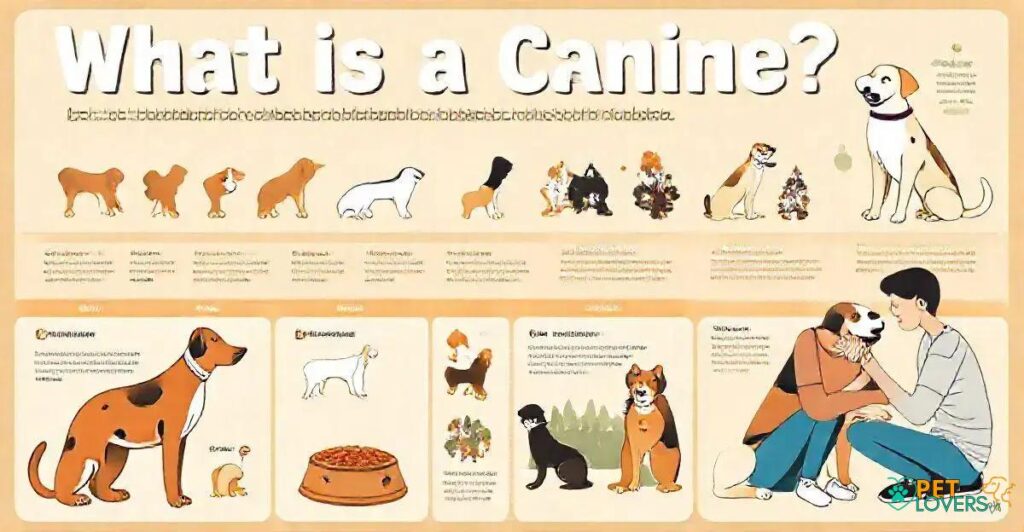Canines, or domesticated dogs, have coexisted with humans for thousands of years, showcasing unique physical traits and a rich history. As social animals, they thrive on interaction and require a balanced diet, regular exercise, and proper training to maintain health and good behavior. Their loyal and affectionate nature has made them beloved companions, often referred to as man’s best friend.
Are you ready to learn more about the amazing world of canines? From their ancient origins to their modern-day popularity, canines have captured the hearts of humans for thousands of years.
But what exactly is a canine? In this article, we’ll delve into the fascinating history and characteristics of these incredible animals, exploring everything from their physical attributes to their behavior and training.
History of Canines
The domestication of canines is believed to have occurred between 15,000 to 30,000 years ago, with evidence suggesting that wolves were attracted to human camps and settlements, where they scavenged food scraps and developed a symbiotic relationship with humans. Over time, humans may have begun to actively encourage and breed these wolves, leading to the development of the first domesticated canines. Archaeological evidence has revealed the presence of canines in ancient human cultures, with depictions of canines appearing in prehistoric art and literature.
Canines are characterized by their distinctive physical features, including their pointed ears, floppy ears, and curled tails. They come in a wide range of sizes, from the tiny Chihuahua to the massive Great Dane. Canines also exhibit a variety of coat types, including short-haired, long-haired, and wire-haired, and can display a range of colors, including solid, bi-colored, and tri-colored. In addition to their physical characteristics, canines are also known for their unique behavioral traits, such as their ability to learn and understand human language.
Canines are omnivores, which means they eat both plants and animals. Their diet typically consists of a combination of commercial dog food, fruits, vegetables, and lean proteins. Canines require a balanced diet that meets their nutritional needs, which include protein, fat, carbohydrates, vitamins, and minerals. A well-balanced diet is essential for maintaining a canine’s overall health and preventing common health problems, such as obesity and dental disease.
Canines are highly social animals that thrive on interaction and attention. They are capable of forming strong bonds with their human families and can be trained to perform a wide range of behaviors, from simple obedience commands to complex tasks. Positive reinforcement training methods, such as reward-based training, are effective for teaching canines new behaviors and improving their behavior. Consistency, patience, and clear communication are essential for successful training.
Physical Characteristics
The domestication of canines is believed to have occurred between 15,000 to 30,000 years ago, with evidence suggesting that wolves were attracted to human camps and settlements, where they scavenged food scraps and developed a symbiotic relationship with humans. Over time, humans may have begun to actively encourage and breed these wolves, leading to the development of the first domesticated canines.
Canines are characterized by their distinctive physical features, including their pointed ears, floppy ears, and curled tails. They come in a wide range of sizes, from the tiny Chihuahua to the massive Great Dane. Canines also exhibit a variety of coat types, including short-haired, long-haired, and wire-haired, and can display a range of colors, including solid, bi-colored, and tri-colored.
Canines are omnivores, which means they eat both plants and animals. Their diet typically consists of a combination of commercial dog food, fruits, vegetables, and lean proteins. Canines require a balanced diet that meets their nutritional needs, which include protein, fat, carbohydrates, vitamins, and minerals.
Canines are highly social animals that thrive on interaction and attention. They are capable of forming strong bonds with their human families and can be trained to perform a wide range of behaviors, from simple obedience commands to complex tasks. Positive reinforcement training methods, such as reward-based training, are effective for teaching canines new behaviors and improving their behavior.
Diet and Nutrition
Canines require a balanced diet that meets their nutritional needs, including protein, fat, carbohydrates, vitamins, and minerals. A well-balanced diet is essential for maintaining a canine’s overall health and preventing common health problems, such as obesity and dental disease. Commercial dog food is a convenient option, but it’s also important to supplement their diet with fruits, vegetables, and lean proteins. Additionally, canines have specific dietary needs based on their age, size, and breed, so it’s essential to consult with a veterinarian to determine the best diet for your canine companion.
Behavior and Training
Canines are highly social animals that thrive on interaction and attention. They are capable of forming strong bonds with their human families and can be trained to perform a wide range of behaviors, from simple obedience commands to complex tasks.
Positive reinforcement training methods, such as reward-based training, are effective for teaching canines new behaviors and improving their behavior. Consistency, patience, and clear communication are essential for successful training.
Additionally, socialization is crucial for canines, as it helps them develop good manners and reduces the risk of behavioral problems.
Conclusion
The adoption of Artificial Intelligence (AI) can bring numerous benefits to small businesses, from automating repetitive tasks to personalizing customer service and analyzing data.
The implementation of AI should be done gradually, identifying areas that can benefit immediately and conducting pilot projects to assess the efficiency of these solutions.
Success stories in different sectors show how AI can be a powerful tool to boost growth and improve operational efficiency.
With AI, small businesses can not only compete on equal footing with larger companies but also innovate and create new opportunities in the market.
Therefore, do not overlook the potential of AI to revolutionize your business.
Final Thoughts on Canines
In conclusion, canines are fascinating animals that have been by humans’ side for thousands of years. From their history and physical characteristics to their diet and behavior, there is much to learn and appreciate about these incredible creatures.
As we have seen, canines are capable of forming strong bonds with their human families and can be trained to perform a wide range of behaviors. With proper care and attention, canines can thrive and bring joy and companionship to our lives.
Whether you are a seasoned dog owner or just considering bringing a canine into your life, it is essential to understand the needs and behaviors of these animals to ensure a happy and healthy relationship.
In summary, canines are truly remarkable animals that deserve our admiration and respect.
FAQ – Frequently Asked Questions About Canines
What is the best way to care for a canine?
Canines require a balanced diet, regular exercise, and plenty of attention and affection. It’s also essential to provide regular veterinary care and keep their living space clean and comfortable.
How can I train a canine?
Positive reinforcement training methods, such as reward-based training, are effective for teaching canines new behaviors. Consistency, patience, and clear communication are also essential for successful training.
What are the common health problems in canines?
Canines are prone to various health problems, including obesity, dental disease, and hip dysplasia. Regular veterinary care and a healthy lifestyle can help prevent or manage these issues.
How can I socialize a canine?
Socialization is crucial for canines, as it helps them develop good manners and reduces the risk of behavioral problems. Expose your canine to new people, places, and experiences to help them become a well-adjusted and confident companion.
What are some common behaviors in canines?
Canines are known for their loyalty, playfulness, and affectionate nature. They may also exhibit behaviors such as barking, whining, and digging, which can be managed with proper training and attention.
Can I have a canine if I live in an apartment?
Yes, canines can thrive in apartment living as long as they receive regular exercise and attention. Look for breeds that are well-suited for apartment living, such as smaller breeds or those with low energy levels.

